When a patient’s information is missing or inaccurate, it can delay treatment and jeopardize health outcomes. Healthcare data governance helps organizations avoid these scenarios by establishing effective policies and processes for managing data. This guide will discuss the significance of healthcare data governance and how it allows organizations to tackle their goals, like achieving operational excellence and improving patient outcomes, through effective data management solutions.
One data management solution that can help organizations achieve these objectives is Azulity’s healthcare data management services. This solution streamlines data governance by creating a trusted repository of health data that reduces redundancies and inaccuracies while boosting organizational efficiency.
What Is Healthcare Data Governance

Healthcare data governance is a formal approach to collecting, managing, and analyzing healthcare data in a transparent way that meets regulatory and ethical standards. Effective data governance in healthcare ensures that data is organized, protected, and used efficiently. This leads to better patient outcomes, compliance, and operational efficiency. Data is everywhere in healthcare organizations. The more accessible and reliable it is, the more likely you are to develop insights from it, says Jonathan Shannon, associate vice president of healthcare strategy at LexisNexis. On the other hand, he adds, “Your entire business suffers in various ways when data governance policies are poor.”
Signs of Poor Healthcare Data Governance
Poor data governance in healthcare can have significant business implications. Shannon points to the referral process. There are multiple benefits to referring patients to in-network providers: Patients avoid the high cost of seeing physicians not covered by their insurance plan, and organizations keep patient defections to a minimum. If provider directories are inaccurate — and data from the Centers for Medicare and Medicaid Services indicates that 49 percent are — he says it’s much harder to make in-network referrals. “Fundamental procedures may be sent up the road and out of the network because someone didn’t know.”
More broadly, poor data governance in healthcare can have significant business implications. Shannon points to the referral process. There are multiple benefits to referring patients to in-network providers: Patients avoid the high cost of seeing physicians not covered by their insurance plan, and organizations keep patient defections to a minimum. If provider directories are inaccurate — and data from the Centers for Medicare and Medicaid Services indicates that 49 percent are — he says it’s much harder to make in-network referrals. “Very important procedures may be sent up the road and out of the network because someone didn’t know.”
Finally, poor governance poses security and regulatory risks. The 21st Century CURES Act requires organizations to make data available to other healthcare stakeholders, including patients. Shannon says this requires a delicate balance between security and availability. “Now, there’s more pressure to make data more accessible,” he says, primarily with open application programming interfaces. “Without data governance, you can’t support open access with APIs.”
Related Reading
- Data Quality Management in Healthcare
- How to Secure Patient Data
- Master Data Management Solutions
- Patient Data Management System
Pillars of Data Governance in Healthcare


Data Quality: The Backbone of Effective Healthcare Data Governance
Data quality refers to data accuracy, completeness, consistency, and timeliness. Ensuring high-quality data is crucial for decision-making processes and deriving accurate insights. Data governance practices related to data quality involve defining data standards, establishing data validation and cleansing processes, and implementing data quality monitoring and reporting mechanisms.
Data Stewardship: Your Healthcare Data Governance Safety Net
Data stewardship focuses on accountability and responsibility for managing and maintaining data assets. Data stewards oversee data quality, ensure compliance with policies and procedures, resolve data-related issues, and facilitate data governance initiatives. They collaborate with data owners, custodians, and users to establish data standards, define data usage guidelines, and enforce data governance policies.
Data Protection and Compliance: The Security Pillar of Healthcare Data Governance
Data protection and compliance address the security and privacy aspects of data governance. Organizations must safeguard sensitive data from unauthorized access, breaches, or misuse. This pillar involves implementing security controls, encryption, access management, and data classification policies to protect data assets. It also includes ensuring compliance with relevant regulations like the General Data Protection Regulation (GDPR) or the Health Insurance Portability and Accountability Act (HIPAA).
Data Management: The Framework of Healthcare Data Governance
Data management encompasses the processes and practices for effectively managing data throughout its lifecycle. It involves data governance activities like integration, architecture, modeling, storage, retention, and lifecycle management. By establishing comprehensive data management practices, organizations can streamline data workflows, reduce data silos, and improve data accessibility and usability.
Azulity specializes in healthcare master data management, bringing proven expertise in implementing healthcare data solutions and credentialing across the US. Our comprehensive platform ensures consistent patient, provider, location, and claims data synchronization across all systems and departments. Key features include healthcare MDM, provider MDM, reference data management, credentialing, and provider enrollment. We serve healthcare technology leaders – from CIOs and CDOs to VPs of data platforms and credentialing – helping them eliminate the costly problems of fragmented data systems. Book a call to learn more about our healthcare master data management services today!
8 Best Practices for Healthcare Data Governance


1. Use Azulity
Azulity is a leading expert in healthcare master data management. The company helps healthcare organizations eliminate the costly problems of fragmented data systems. Their comprehensive platform ensures consistent patient, provider, location, and claims data synchronization across all systems and departments. Key features include healthcare MDM, provider MDM, reference data management, credentialing, and provider enrollment. Azulity serves healthcare technology leaders—from CIOs and CDOs to VPs of data platforms and credentialing. Book a call to learn more about our healthcare master data management services today!
2. Establish a Data Governance Framework
A data governance framework is a set of policies, procedures, and standards that define how data is managed and used within an organization. Healthcare organizations need a data governance framework to ensure that their data is secure, compliant, and accessible to those who need it. You should identify the key stakeholders in your organization’s data management to establish a data governance framework. This may include clinical, IT, legal, and compliance department representatives. Once you have identified the key stakeholders, you should work with them to develop a framework that addresses the following areas:
Data ownership and Stewardship
Who owns and is responsible for different data types within your organization?
Data access and sharing
Who has access to other data types, and how is it shared?
Data security and privacy
How is data protected from unauthorized access, use, or disclosure?
Data quality
How do you ensure your data is accurate, complete, and timely?
Data retention and disposal
How long do you keep different data types, and how is it disposed of when it is no longer needed? Once you have developed a data governance framework, you must communicate it to all staff members and train them on their roles and responsibilities. You should also regularly review and update your framework to ensure it remains effective.
Example
The Cleveland Clinic developed a framework for data governance that includes standardized policies and stakeholder roles. Their framework sets policies for data ownership and defines who can access different data types (e.g., sensitive patient information). This reduces risks by ensuring consistent data security practices, aligning with HIPAA requirements, and facilitating compliance reviews.
3. Define Data Roles and Responsibilities
Once you have established a data governance framework, you must define the data roles and responsibilities for different individuals and teams within your organization. This will help to ensure that everyone knows who is responsible for what data and that data is managed and used consistently across the organization. Data roles and responsibilities are essential for ensuring data is managed and used effectively in healthcare organizations. By clearly defining and communicating data roles and responsibilities, you can help to improve data quality, security, and compliance. Some key data roles and responsibilities include:
Data owner
The data owner is responsible for a specific data type’s overall management and governance. This may include setting data standards, managing data access, and ensuring that data is used in compliance with all applicable regulations.
Data steward
The data steward is responsible for managing a specific data type. This may include data quality assurance, data reporting, and data analysis.
Data user
Data users are anyone who accesses or uses data. This may include clinicians, researchers, and administrative staff. It is essential to clearly define the roles and responsibilities for each data role and communicate them to all staff members. You should also develop training programs to help staff members understand their roles and responsibilities and how to comply with your organization’s data governance policies.
Example
Kaiser Permanente introduced defined data roles (e.g., data stewards and owners) to ensure accountability. Data stewards focus on the quality of patient information, tracking metrics like error rates and response times. As data users, clinicians access the data, following specific guidelines to prevent unauthorized disclosures. Such role clarity enhances data quality, security, and compliance with legal standards.
4. Develop Data Standards and Policies
Developing data standards and policies is crucial in streamlining healthcare information systems. When you establish clear guidelines for data management, you’re promoting efficiency and safeguarding the integrity and security of the information you handle. A vital place to start would be defining what constitutes ‘standard data’ in your organization. This can include classification systems and terminologies, such as the International Classification of Diseases (ICD) or the Systematized Nomenclature of Medicine – Clinical Terms (SNOMED CT). Standardization ensures that there’s a common language spoken across not just your organization but also the broader healthcare sector.
Regarding policies, you need mechanisms to control how data is collected, stored, processed, and shared. A forward-looking approach would be designing policies that align with your organization’s values and the law, including the landmark Health Insurance Portability and Accountability Act (HIPAA).
Example
Intermountain Healthcare standardized its data by implementing common terminologies like ICD and SNOMED. They use consistent classification across their records, making data comparable and interoperable between hospitals, labs, and other departments. They also adopted policies to ensure all patient data complies with HIPAA regulations and internal standards for handling and sharing data.
5. Implement Data Quality Management
Data quality management (DQM) ensures that data is accurate, complete, timely, consistent, and accessible. Healthcare organizations must implement DQM programs to ensure their data is reliable and can be used to make informed decisions about patient care, population health, and operational efficiency. You can take several steps to implement a DQM program in your healthcare organization:
1. Identify your data quality goals
What specific data quality issues do you need to address? For example, do you need to improve the accuracy of your patient records? Reduce the number of duplicate records. Or make your data more accessible to clinicians and researchers?
2. Assess your current data quality
Once you know your data quality goals, you need to assess your current data quality to identify areas for improvement. You can do this using data quality tools and techniques, such as data profiling, cleansing, and matching.
3. Develop and implement data quality policies and procedures
Once you have identified your data quality goals and assessed your current data quality, you must develop and implement data quality policies and procedures. These policies and procedures should define the roles and responsibilities for data quality, as well as the specific steps that should be taken to ensure data quality.
4. Monitor and evaluate your data quality program
Regularly monitoring and evaluating your data quality program is essential to ensure it is effective and meets your goals. You can do this by tracking key performance indicators (KPIs), such as the percentage of accurate records, the number of duplicate records, and the average time it takes to resolve data quality issues. DQM is essential for healthcare organizations to ensure that their data is reliable and can be used to make informed decisions. By implementing a DQM program, you can improve the quality of your data, reduce errors, and save money.
Example
The Mayo Clinic deployed a Data Quality Management (DQM) program to improve patient data accuracy. Using data profiling and cleansing tools, they’ve minimized duplicate patient records and enhanced data accessibility for clinicians. Monitoring data quality metrics, like completeness and accuracy, supports patient safety initiatives by ensuring reliable and timely access to information.
6. Protecting Data Security and Privacy in Healthcare Organizations
Protecting data security and privacy is essential for healthcare organizations. Data breaches can lead to the theft of sensitive patient information, such as names, addresses, and medical histories. This information can be used for fraud, identity theft, or other criminal activities. There are several things that healthcare organizations can do to protect data security and privacy:
Implement data encryption
Data encryption converts data into a format that authorized individuals can only read. By encrypting data, healthcare organizations can help protect it from unauthorized access, even if it is stolen.
Use strong passwords
All users of healthcare organization systems should use strong passwords that are difficult to guess. Passwords should be at least 12 characters long and include a mix of upper and lowercase letters, numbers, and symbols.
Provide security awareness training to staff.
All staff members should be trained on the best data security and privacy practices. This training should cover topics such as password security, phishing scams, and how to identify and report suspicious activity.
Implement a security incident response plan.
Healthcare organizations should have a plan for responding to data security incidents. This plan should include steps for identifying and containing incidents, notifying affected individuals, and investigating the cause of the incident.
Example
Johns Hopkins Health System has implemented encryption for all stored and transmitted patient data, and it trains staff on cybersecurity practices, such as spotting phishing attacks. With a security incident response plan in place, it can quickly address breaches, notify affected patients, and investigate the root causes.
7. Implement Data Quality Management.
A strategic data quality management system is essential for any healthcare organization. Why? because it can significantly impact patient care outcomes. High-quality data is accurate, reliable, timely, relevant, and easily accessible—the importance of data quality. Implementing data quality management starts with a structured process. First, define what quality metrics to track. Focus on the completeness, accuracy, consistency, and timeliness of data.
Then, set up methods for capturing and measuring these metrics. Data quality management isn’t a one-off process but an ongoing one. Regular audits and assessments of data quality are crucial. A system that effectively identifies and addresses inaccuracies can lead to marked improvements in patient care. Consider, for example, that inaccurate patient identification and wrong data matching cost the U.S. healthcare system $6 billion annually.
Considering the humongous amount of data that healthcare organizations tackle daily, manual data quality management may take time and effort. This is where technology comes in. Investing in sophisticated data quality tools can automate the process and deliver more accurate results. Tools and technologies Speaking of technology, AI and Machine learning have come into the spotlight in recent years. These technologies can provide unparalleled assistance in managing data quality.
With rigorous checking of data consistency and detection of anomalies, these tools can make an impactful difference. Health IT Analytics predicts that by 2025, 95% of data in the healthcare sector will be relevant and valuable all because of the use of such innovative tools in data quality management. To sum it up, implementing data quality management is non-negotiable for the success of your healthcare organization. While it may require an initial investment in resources and capital, the returns regarding efficient healthcare services and patient safety are undeniable. This makes data quality management a must-have component in today’s data-driven healthcare environment.
Example
Boston Children’s Hospital uses AI-powered tools to check data consistency and catch anomalies in patient records. This automated approach identifies errors before they impact clinical decisions, enhancing patient safety. These tools support ongoing data quality improvement, reducing manual efforts and potential errors.
8. Monitor and Evaluate Data Governance
Monitoring and evaluating data governance is integral to ensuring data integrity and relevance in healthcare organizations. It’s not enough to put a data governance strategy into place; you must continually scrutinize these systems to verify they meet your desired goals. Identifying key metrics to measure data governance effectiveness is pivotal in this endeavor. You might want to measure the frequency of data errors, the percentage of incomplete records, or the accuracy of decision-making information. By monitoring these metrics, you gain insight into whether your data governance strategy is effective or needs tweaks. Add to these metrics a periodic review of data breaches and security incidents.
This is crucial as, per a survey by Black Book Market Research, in 2020, 73% of health systems reported having compromised data security in some way. Moreover, 93% said they prioritize proactive data governance and management. An effective data governance review process starts with assembling your governance committee – a multidisciplinary team that includes physicians, IT professionals, and administrative personnel. This team can spearhead the review process by regularly evaluating these metrics, identifying loopholes, and brainstorming strategies for improvement.
Example
The University of Pittsburgh Medical Center has a data governance review committee that monitors data quality metrics and evaluates data security incidents. By reviewing governance metrics like data error rates and incidents of unauthorized access, the committee identifies areas for improvement and refines policies to mitigate risks.
7 Best Healthcare Data Governance Tools For All Your Needs
1. Azulity: Synchronizing Master Data to Eliminate Fragmentation
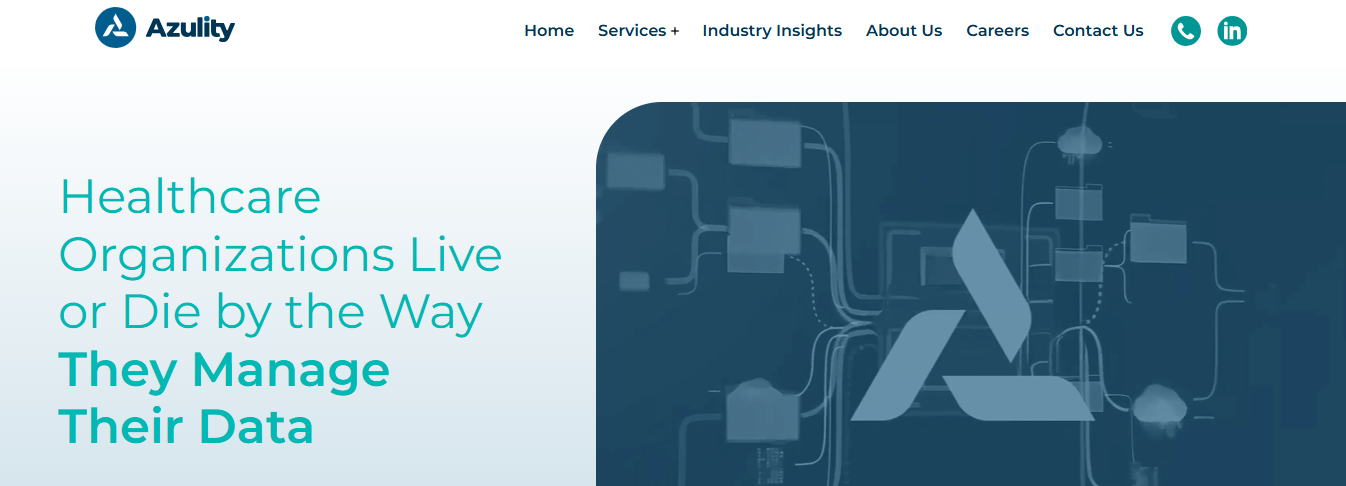

Azulity specializes in healthcare master data management, bringing proven expertise in implementing healthcare data solutions and credentialing across the US. Their comprehensive platform ensures consistent patient, provider, location, and claims data synchronization across all systems and departments. Key features include healthcare MDM, provider MDM, reference data management, credentialing, and provider enrollment. Azulity serves healthcare technology leaders, helping them eliminate the costly problems of fragmented data systems.
2. Ataccama One: Streamlining Governance Processes Through AI
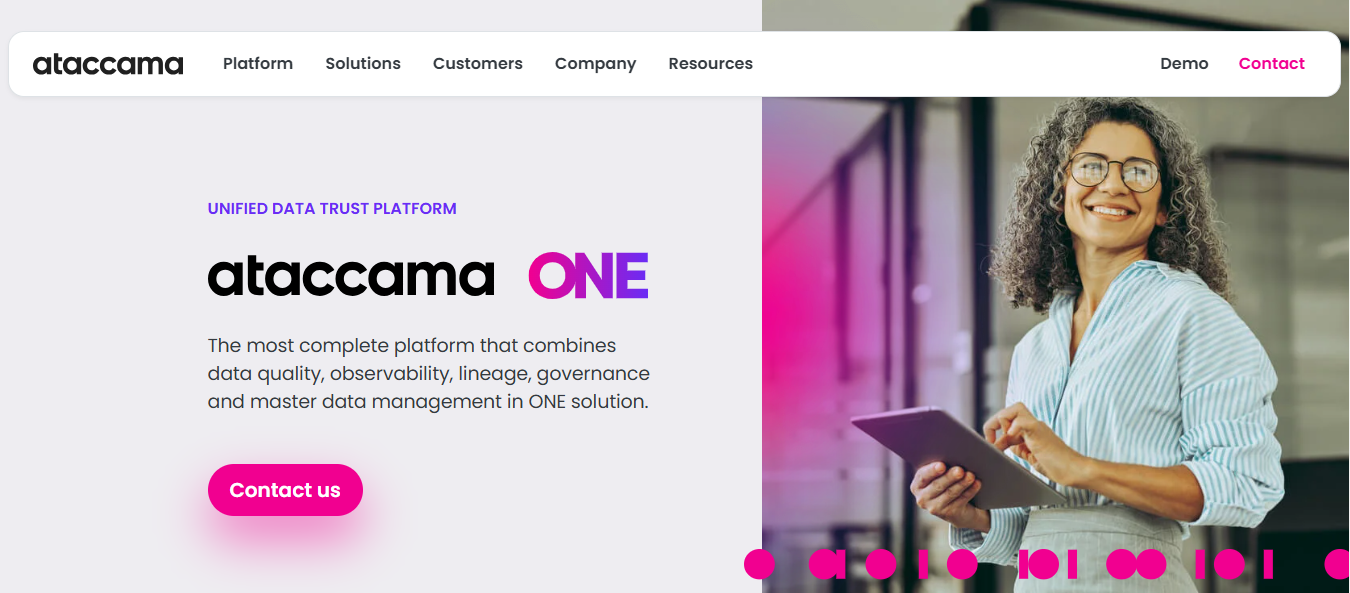

Ataccama One is a data governance and management solution that operates across on-premises, cloud, and hybrid environments. It is an AI-driven tool that supports data governance teams, stewards, scientists, and engineers by streamlining data governance processes through automation and intelligence.
Pros
- It offers governance features, including data lineage and access controls, establishing data security.
- Provides detailed profiling and management of metadata, allowing for improved data understanding and governance across the data lifecycle.
- Implement role-based access controls and stewardship capabilities, ensuring authorized personnel have access to and manage data, and aligning with governance policies.
Cons
- Integrating Atacama with your current systems can be complicated and requires technical skills.
- It is resource-intensive, especially when it comes to large datasets.
3. Erwin Data Intelligence: A Unified Approach to Healthcare Data Governance
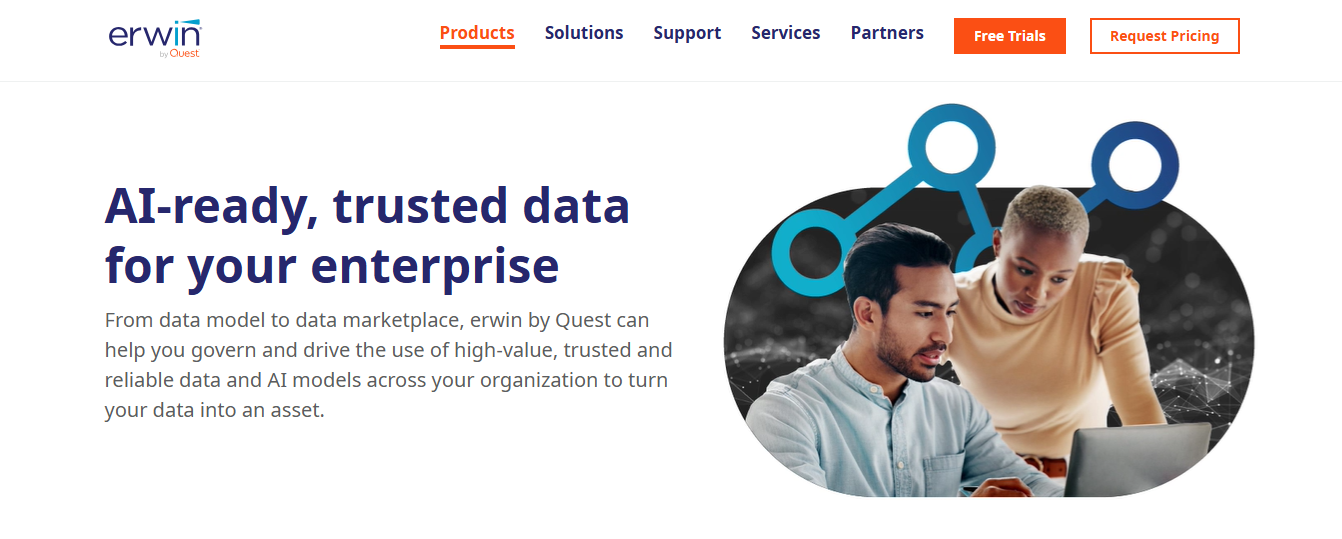

Erwin Data Intelligence by Quest streamlines enterprise data governance by offering tools that include data cataloging, quality assurance, and data literacy. The software’s integrated approach promotes informed decision-making and compliance with internal policies.
Pros
- Collects and catalogs metadata, simplifies data generation lineage, and performs data quality assessments.
- Helps create and maintain a centralized repository of business terms and definitions.
- Enables tracing of data origin and transformations throughout its lifecycle, supporting transparency, compliance, and auditability in data governance efforts.
Cons
- The tool’s performance slows down with larger models, making report generation challenging.
- Generating reports for large models can be time-consuming and may lead to application crashes, resulting in lost changes.
4. Collibra: Improving Healthcare Data Governance with Advanced Features
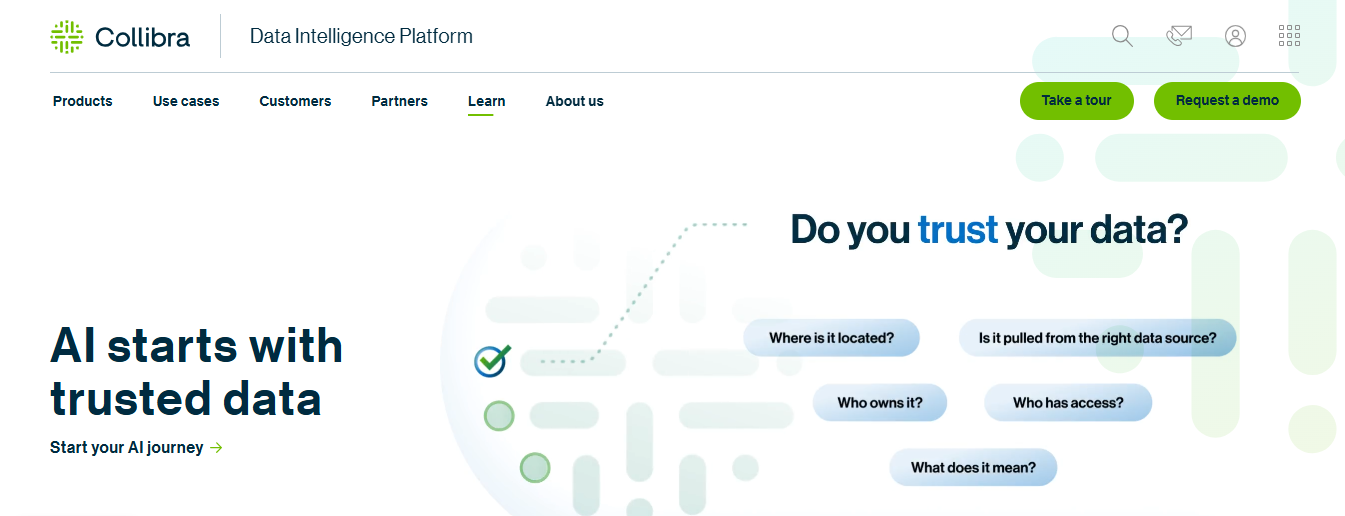

Collibra Data Governance is a component of the Collibra Data Intelligence Cloud platform, designed to improve data governance and management within organizations.
Pros
- Offers a Policy Manager application for centralized control of data policies and standards.
- Supports metadata documentation through its data dictionary, enabling users to find and understand data easily.
- Provides visualization of data lineage, showing the journey of data across systems and how it is processed and used.
Cons
- It requires intensive training to use its advanced features and automation, which can be challenging initially.
- Getting all its features to work well with the systems might be challenging if you are new to it.
5. OvalEdge: Automating Data Governance to Enhance Healthcare Insights
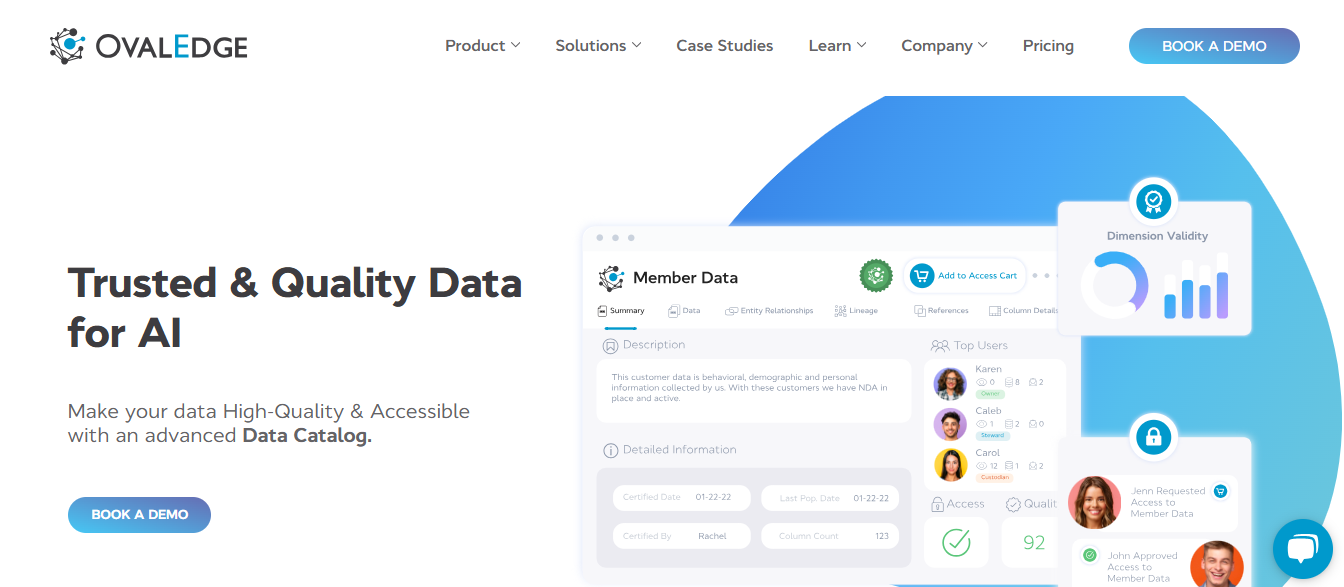

OvalEdge is a data management tool that automates data categorization and indexing. It can be used on-premises or in the cloud, offering data discovery, governance, and policy management features.
Pros
- Utilizes NLP and ML to organize data with tags, usage statistics, and custom tags, simplifying data discovery and organization.
- Crawls data sources, including data lakes and analytics software, to index metadata, enhancing data understanding and governance.
- Generates reports on data usage and errors, offering valuable insights into data health and activity.
Cons
- The data quality feature must be more developed and contain many minor bugs.
- The visual interface is prone to errors.
6. Informatica: A Complex Solution for Comprehensive Healthcare Data Governance


Informatica offers a data governance solution that helps organizations manage and govern their data across multiple cloud platforms.
Pros
- Automatically scans and indexes metadata, enhancing data understanding and governance.
- Integrates master data management and AI-based integration patterns to ensure accurate and consistent data.
- Offers visualization of data lineage and history, supporting automated tracing of data movement for impact analysis and compliance.
Cons
- The tool’s high complexity demands extensive training and lacks customization options for relationships, limiting visual and integrative capabilities.
- Navigation is complicated and offers limited scheduling options, and performance struggles when multiple jobs are scheduled.
7. Oracle Enterprise Metadata Management: Cataloging Healthcare Metadata for Better Governance


OEMM is a tool for harvesting, cataloging, and governing metadata from various data sources. Its features enable organizations to gain a comprehensive understanding of their metadata landscape.
Pros
- Automatically gathers metadata from various sources, enabling a unified view across relational databases, data warehouses, and BI platforms.
- Offers detailed data lineage tracing and impact analysis functions, aiding in understanding the data flow and the implications of data changes.
- Smoothly integrates with Oracle Enterprise Data Quality, supporting a comprehensive data governance strategy.
Cons
- The system demands extensive training for proper management and a complex interface that requires in-depth study before professional use.
- The user interface is prone to glitches and can be slow to respond, impacting efficiency and usability.
Related Reading
- Healthcare Provider Data Management
- MDM Implementation
- Reference Data Management
- Healthcare Data Integration
- Healthcare IT Consultants
Book a Call to Learn More About Our Healthcare Master Data Management Services
Azulity specializes in healthcare master data management, bringing proven expertise in implementing healthcare data solutions and credentialing across the US. Our comprehensive platform ensures consistent patient, provider, location, and claims data synchronization across all systems and departments.
Key features include healthcare MDM, provider MDM, reference data management, credentialing, and provider enrollment. We serve healthcare technology leaders – from CIOs and CDOs to VPs of data platforms and credentialing – helping them eliminate the costly problems of fragmented data systems. Book a call to learn more about our healthcare master data management services today!